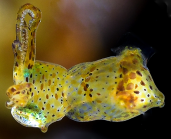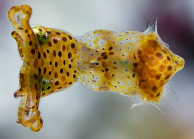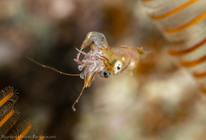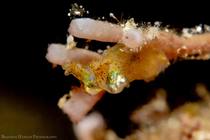WoRMS taxon details
Kodama jujutsu A. Reid, N. Sato, Jolly & Strugnell, 2023
1716239 (urn:lsid:marinespecies.org:taxname:1716239)
accepted
Species
marine, brackish, fresh, terrestrial
Reid, A., Sato, N., Jolly, J. & Strugnell, J. (2023). Two new pygmy squids, <i>Idiosepius kijimuna</i> n. sp. and <i>Kodama jujutsu</i> n. gen., n. sp. (Cephalopoda: Idiosepiidae) from the Ryukyu Islands, Japan. <em>Marine Biology.</em> 170: 167: 1-26., available online at https://doi.org/10.1007/s00227-023-04305-1
page(s): 16, figs 1, 6-12 [details] Available for editors [request]
[request]
page(s): 16, figs 1, 6-12 [details] Available for editors
Holotype NSMT Mo 85932, geounit Okinawa Island
Holotype NSMT Mo 85932, geounit Okinawa Island [details]
Etymology The specific name jujutsu is derived from the Japanese word jūjutsu that is a martial art of the same name, translating to...
Etymology The specific name jujutsu is derived from the Japanese word jūjutsu that is a martial art of the same name, translating to ‘gentle art’. The goal of the sport is to control your opponents by grappling them. This pygmy squid has been seeing grappling shrimp in a similar fashion. The name is used as a noun in apposition. [details]
MolluscaBase eds. (2024). MolluscaBase. Kodama jujutsu A. Reid, N. Sato, Jolly & Strugnell, 2023. Accessed through: World Register of Marine Species at: https://www.marinespecies.org/aphia.php?p=taxdetails&id=1716239 on 2024-05-03
Date
action
by
![]() The webpage text is licensed under a Creative Commons Attribution 4.0 License
The webpage text is licensed under a Creative Commons Attribution 4.0 License
original description
Reid, A., Sato, N., Jolly, J. & Strugnell, J. (2023). Two new pygmy squids, <i>Idiosepius kijimuna</i> n. sp. and <i>Kodama jujutsu</i> n. gen., n. sp. (Cephalopoda: Idiosepiidae) from the Ryukyu Islands, Japan. <em>Marine Biology.</em> 170: 167: 1-26., available online at https://doi.org/10.1007/s00227-023-04305-1
page(s): 16, figs 1, 6-12 [details] Available for editors [request]
[request]
page(s): 16, figs 1, 6-12 [details] Available for editors
 Present
Present  Present in aphia/obis/gbif/idigbio
Present in aphia/obis/gbif/idigbio  Inaccurate
Inaccurate  Introduced: alien
Introduced: alien  Containing type locality
Containing type locality
Holotype NSMT Mo 85932, geounit Okinawa Island [details]
From editor or global species database
Etymology The specific name jujutsu is derived from the Japanese word jūjutsu that is a martial art of the same name, translating to ‘gentle art’. The goal of the sport is to control your opponents by grappling them. This pygmy squid has been seeing grappling shrimp in a similar fashion. The name is used as a noun in apposition. [details]Habitat Kodama jujutsu is found around coral reefs and has been seen hunting and foraging after sunset, often in open water near reef cuts. Underwater naturalist and photographer, Shawn Miller, has captured a typical, possibly defence posture (Fig. 10a, c–h) in which the animal spreads the arms and sometimes the tentacles out widely in a circle surrounding the mouth, with the distal tips of these appendages curved inwards. Sometimes the arms are extended dorsally above the head. This can be accompanied by the contraction of the mantle posterior to the fins forming a rounded nipplelike tip. They readily follow shrimp attracted to dive camera lights or torches at night. The species has also been found in shallow seagrass beds. It first attracted Brandon Ryan Hannan’s attention in 2019 when he noticed the unusual protrusions below the eyes and observed the species attaching itself to the underside of coral or any underwater substrate. At the popular Sunabe Seawall dive site in Okinawa he observed K. jujutsu attached to the undersides of various hydroids to which the hydroid nematocysts (stinging cells) do not deter K. jujutsu. A further interesting observation was made in 2019 of the pygmy squid attached to a hydroid that the swimming nudibranch, Bornella anguilla S. Johnson, 1984 was eating (Fig. 12a). When the nudibranch reached the end of the hydroid it did not touch the squid and the squid didn’t move. Clearly the squid was not concerned about the nudibranch—testament to the fact that nudibranchs are generally highly specialised feeders. In this case, the hydroid, and not the pygmy squid is the target for B. anguilla. (The species is known to extend its buccal bulb and hydroid branches are drawn into the mouth to be stripped of its polyps.) The species has been observed numerous times during diving around Okinawa at night and sometimes at dusk in water with temperatures ranging between 20 and 27 °C. When observed eating, the prey was always small shrimp with bodies smaller or similar in size to themselves (B. Hannan, personal observations, Fig. 12b, c). [details]





